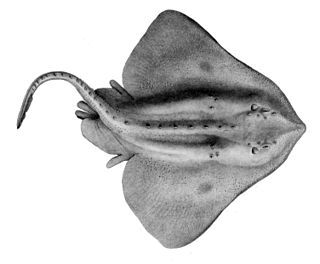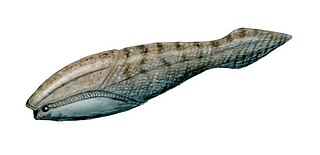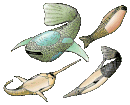
A chordate is a deuterostomic animal belonging to the phylum Chordata. All chordates possess, at some point during their larval or adult stages, five distinctive physical characteristics (synapomorphies) that distinguish them from other taxa. These five synapomorphies are a notochord, a hollow dorsal nerve cord, an endostyle or thyroid, pharyngeal slits, and a post-anal tail. The name "chordate" comes from the first of these synapomorphies, the notochord, which plays a significant role in chordate body plan structuring and movements. Chordates are also bilaterally symmetric, have a coelom, possess a closed circulatory system, and exhibit metameric segmentation.

Chondrichthyes is a class of jawed fish that contains the cartilaginous fish or chondrichthyians, which all have skeletons primarily composed of cartilage. They can be contrasted with the Osteichthyes or bony fish, which have skeletons primarily composed of bone tissue. Chondrichthyes are aquatic vertebrates with paired fins, paired nares, placoid scales, conus arteriosus in the heart, and a lack of opecula and swim bladders. Within the infraphylum Gnathostomata, cartilaginous fishes are distinct from all other jawed vertebrates.

Agnatha is an infraphylum of jawless fish in the phylum Chordata, subphylum Vertebrata, consisting of both living (cyclostomes) and extinct species. Among recent animals, cyclostomes are sister to all vertebrates with jaws, known as gnathostomes.

Gnathostomata are the jawed vertebrates. Gnathostome diversity comprises roughly 60,000 species, which accounts for 99% of all living vertebrates, including humans. In addition to opposing jaws, living gnathostomes have true teeth, paired appendages, the elastomeric protein of elastin, and a horizontal semicircular canal of the inner ear, along with physiological and cellular anatomical characters such as the myelin sheaths of neurons, and an adaptive immune system that has the discrete lymphoid organs of spleen and thymus, and uses V(D)J recombination to create antigen recognition sites, rather than using genetic recombination in the variable lymphocyte receptor gene.

Haikouella is an agnathan chordate from the Lower Cambrian Maotianshan Shales of Chengjiang County in Yunnan Province, China. An analysis in 2015 placed Haikouella as a junior synonym of Yunnanozoon, another Maotianshan shale Cambrian chordate.

Haikouichthys is an extinct genus of craniate that lived 518 million years ago, during the Cambrian explosion of multicellular life. Haikouichthys had a defined skull and other characteristics that have led paleontologists to label it a true craniate, and even to be popularly characterized as one of the earliest fishes. Cladistic analysis indicates that the animal is probably a basal chordate or a basal craniate; but it does not possess sufficient features to be included uncontroversially even in either stem group. It was formally described in 1999.

Lungfish are freshwater vertebrates belonging to the class Dipnoi. Lungfish are best known for retaining ancestral characteristics within the Osteichthyes, including the ability to breathe air, and ancestral structures within Sarcopterygii, including the presence of lobed fins with a well-developed internal skeleton. Lungfish represent the closest living relatives of the tetrapods. The mouths of lungfish typically bear tooth plates, which are used to crush hard shelled organisms.

Fish anatomy is the study of the form or morphology of fish. It can be contrasted with fish physiology, which is the study of how the component parts of fish function together in the living fish. In practice, fish anatomy and fish physiology complement each other, the former dealing with the structure of a fish, its organs or component parts and how they are put together, such as might be observed on the dissecting table or under the microscope, and the latter dealing with how those components function together in living fish.

Skates are cartilaginous fish belonging to the family Rajidae in the superorder Batoidea of rays. More than 150 species have been described, in 17 genera. Softnose skates and pygmy skates were previously treated as subfamilies of Rajidae, but are now considered as distinct families. Alternatively, the name "skate" is used to refer to the entire order of Rajiformes.

Arandaspida is a taxon of very early, jawless prehistoric fish which lived during the Ordovician period. Arandaspids represent the oldest known craniates, a proposed group of chordates that contain all chordates with a cartilage-derived skull, and hagfish. The group represents a subclass within the class Pteraspidomorphi, and contains only one order, the Arandaspidiformes. The oldest known genus of this group is Sacabambaspis found in South America.

Thelodonti is a class of extinct Palaeozoic jawless fishes with distinctive scales instead of large plates of armor.

Rajiformes is one of the four orders in the superorder Batoidea, flattened cartilaginous fishes related to sharks. Rajiforms are distinguished by the presence of greatly enlarged pectoral fins, which reach as far forward as the sides of the head, with a generally flattened body. The undulatory pectoral fin motion diagnostic to this taxon is known as rajiform locomotion. The eyes and spiracles are located on the upper surface of the head and the gill slits are on the underside of the body. Most species give birth to live young, although some lay eggs enclosed in a horny capsule.

Tiktaalik is a monospecific genus of extinct sarcopterygian from the Late Devonian Period, about 375 Mya, having many features akin to those of tetrapods. Tiktaalik is estimated to have had a total length of 1.25–2.75 metres (4.1–9.0 ft) based on various specimens.

Astraspis is an extinct genus of primitive jawless fish from the Ordovician of Central North America including the Harding Sandstone of Colorado and Bighorn Mountains of Wyoming. It is also known from Bolivia. It is related to other Ordovician fishes, such as the South American Sacabambaspis, and the Australian Arandaspis.

Sacabambaspis is an extinct genus of jawless fish that lived in the Ordovician period. Sacabambaspis lived in shallow waters on the continental margins of Gondwana. It is the best known arandaspid with many specimens known.

Barameda is a genus of rhizodont lobe-finned fishes which lived during the Tournaisian stage near the start of the Carboniferous period in Australia; fossils of the genus have been reported from the Snowy Plains Formation. The largest member of this genus, Barameda decipiens, reached an estimated length of around 3–4 metres (9.8–13.1 ft), while smallest species, B. mitchelli is estimated to have had a length of about 35 centimetres (14 in).

Fins are moving appendages protruding from the body of fish that interact with water to generate thrust and help the fish swim. Apart from the tail or caudal fin, fish fins have no direct connection with the spine and are supported only by muscles.

The evolution of fish began about 530 million years ago during the Cambrian explosion. It was during this time that the early chordates developed the skull and the vertebral column, leading to the first craniates and vertebrates. The first fish lineages belong to the Agnatha, or jawless fish. Early examples include Haikouichthys. During the late Cambrian, eel-like jawless fish called the conodonts, and small mostly armoured fish known as ostracoderms, first appeared. Most jawless fish are now extinct; but the extant lampreys may approximate ancient pre-jawed fish. Lampreys belong to the Cyclostomata, which includes the extant hagfish, and this group may have split early on from other agnathans.

Redfieldiiformes is an extinct order of ray-finned fish (actinopterygians) which lived from the Middle Triassic to Early Jurassic. Redfieldiiforms were fairly typical Triassic fish in overall anatomy. They had a fusiform body shape with thick, ganoine-covered scales. The dorsal and anal fins were large, positioned opposite from each other, and shifted back, close to the tail. The caudal fin was hemiheterocercal, with the vertebral column and body scales extending into an upper lobe which was equal in size and shape to the lower lobe. They also had several characteristic skeletal traits, such as a hatchet-shaped preopercle, a series of fulcra fringing the fins, a reduced number of branchiostegal rays, and a snout ornamented with tubercles.

Panderodus Is an extinct genus of jawless fish belonging to the order Conodonta. This genus had a long temporal range, surviving from the middle Ordovician to late Devonian. In 2021, extremely rare body fossils of Panderodus from the Waukesha Biota were described, and it revealed that Panderodus had a more thick body compared to the more slender bodies of more advanced conodonts. It also revealed that this conodont was a macrophagous predator, meaning it went after large prey.



























